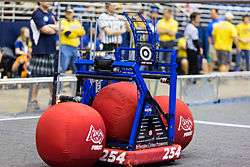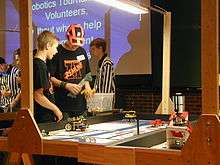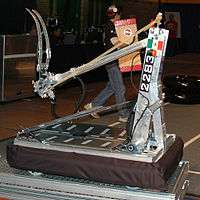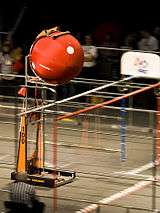For Inspiration and Recognition of Science and Technology
 | |
| Founded | 1989 |
|---|---|
| Founder | Dean Kamen |
| Type | 501(c)(3) not-for-profit public charity |
| Location | |
| Coordinates | 42°59′22″N 71°28′04″W / 42.9895°N 71.4677°W |
Members |
400,000+ students 34,000+ robots 90,000+ mentors 38,700+ teams 90,000+event volunteers[1] |
Key people |
Dean Kamen, Founder Walt Havenstein, Chairman of the Board Don Bossi, President Woodie Flowers, National Adviser[1] |
Revenue | $50,461,022[2] |
Employees | 135 (in 2013)[3] |
Volunteers | 120,000[1] |
| Slogan | "To create a world where science and technology are celebrated... where young people dream of becoming science and technology heroes" |
| Website |
www |
For Inspiration and Recognition of Science and Technology (FIRST) is an international youth organization that operates the FIRST Robotics Competition, FIRST LEGO League, FIRST LEGO League Jr., and FIRST Tech Challenge competitions.[4] Founded by Dean Kamen and Woodie Flowers in 1989, its expressed goal is to develop ways to inspire students in engineering and technology fields. Its philosophy is expressed by the organization as coopertition and gracious professionalism. FIRST also operates FIRST Place, a research facility at FIRST headquarters in Manchester, New Hampshire, where it holds educational programs and day camps for students and teachers.[5]
Structure
FIRST operates as a non-profit public charity corporation. It licenses qualified teams, usually affiliated with schools or other youth organizations, to participate in its competitions. The teams in turn pay a fee to FIRST; these fees, the majority of which are redistributed to pay for teams' kit of parts and other services, consist of the majority of FIRST's revenue.[6]
The supreme body of FIRST is its board of directors, which includes corporate executives and former government officials. FIRST also has an executive advisory board and several senior advisors; these advisors include engineers, involved volunteers, and other senior organizers. Day-to-day operations are run by a senior management team, consisting of a president and five vice presidents.[7]
Activities
Robotics

The first and highest-scale program developed through FIRST is the FIRST Robotics Competition (FRC), which is designed to inspire high school students to become engineers by giving them real world experience working with engineers to develop a robot. The inaugural FIRST Robotics Competition was held in 1992 in the Manchester Memorial High School gymnasium.[8] As of 2009, over 3,000 high school teams totaling over 46,000 students from Australia, Brazil, Canada, Turkey, Israel, Mexico, the Netherlands, the United States, the United Kingdom,[1] and more compete in the annual competition.
The competition challenge changes each year, and the teams can only reuse certain components from previous years. The robots weigh at most 120 pounds (54.4 kg), without batteries and bumpers. The kit issued to each team contains a base set of parts. Registration and the kit of parts together cost about US$6,000. In addition to that, teams are allowed to spend another $3,500 on their robot. The purpose of this rule is to lessen the influence of money on teams' competitiveness. Details of the game have been released on the first Saturday in January (except when that Saturday falls on January 1 or 2), and the teams have been given six weeks to construct a robot that can accomplish the game's tasks.[9]
In 2011, teams participated in 48 regional and district competitions[10][11] throughout March in an effort to qualify for the FIRST Championship in St. Louis in April. Previous years' Championships have been held in Atlanta, Georgia, Houston, Texas and at Walt Disney World's Epcot.[12] On October 7, 2009, FIRST announced that the Championship Event will be held in St. Louis, Missouri for 2011 through 2013.[13] Each year the FIRST Robotics Competition has scholarships for the participants in the program. In 2011, there were over $14 million worth of scholarships from more than 128 colleges and universities, associations, and corporations.
The district competition system was introduced in Michigan and as of 2017 has expanded to Pacific Northwest (Washington and Oregon), MAR (Mid-Atlantic Region), New England, Georgia, North Carolina, Ontario, and Israel (Ontario and Israel introduced as districts in 2017 became the first districts outside the United States. The district competition system changed the traditional "regional" events by allowing teams to compete in multiple smaller events and using an associated ranking algorithm to determine which teams would advance to the next level of the competition. In general, there have been pushes to move more regions to the districts system; California, Texas, and New York have especially been pushed to move to the district system.
Tech Challenge
The FIRST Tech Challenge (FTC), formerly FIRST Vex Challenge (FVC), is a mid-level robotics competition announced by FIRST on March 22, 2005. According to FIRST, this competition was designed to be a more accessible and affordable option for schools. FIRST has also said that the FTC program was created for those of an intermediate skill level. FIRST Tech Challenge robots are approximately one-third the scale of their FRC counterparts. The FTC competition is meant to provide a transition for students from the FLL competition to the FRC competition. FTC was developed for the Vex Robotics Design System, which is available commercially.[14]
The 2005 FVC pilot season featured a demonstration of the FIRST Vex Challenge using a 1/3 linear scale mock-up of the 2004 FRC Competition, FIRST Frenzy: Raising the Bar. For their 2005-2006 Pilot Season, FVC teams played the Half-Pipe Hustle game using racquet balls and ramps.
For the 2006-2007 FTC Season, the FIRST Tech Challenge teams competed in the Hangin'-A-Round challenge using softballs, rotating platforms, a hanging bar, and a larger 'Atlas' ball which is significantly larger than most Vex robots and harder to manipulate.[15][16] Competitions were held around the United States, Canada, and Mexico.[17]
For the 2008-2009 FTC season, a new kit was introduced, as FIRST moved away from the VEX platform and worked with several different vendors to create a custom kit and control system for FTC known as Tetrix. Based around the LEGO Mindstorms NXT "brain" and including secondary specialized controllers to overcome the limitations of the NXT, teams use a Bluetooth link between the NXT and a laptop running FTC driver station software. A team's drivers then use either one or two USB gamepads to control their robots.
For the 2015-2016 FTC season, in a partnership with Qualcomm, the LEGO Mindstorms NXT was replaced as the "brain" of the robot by an android device which communicates to a separate "driver station" android device via Wifi Direct. In addition, students were allowed to use either MIT App Inventor or Android Studio (Java language) to program their robots.
FIRST LEGO League

In 1998, the FIRST LEGO League (FLL), a program similar to the FIRST Robotics Competition, was formed. It is aimed at 9 to 14-year-old students and utilizes LEGO Mindstorms sets (EV3, NXT, RCX) to build palm-sized LEGO robots, which are then programmed using either the ROBOLAB software (RCX-based systems) or Mindstorms NXT or EV3 software (for NXT or EV3-based systems respectively) to autonomously compete against other teams.[18] The ROBOLAB software is based on National Instruments' LabVIEW industrial control engineering software. The combination of interchangeable LEGO parts, computer 'bricks', sensors, and the aforementioned software, provide preteens and teenagers with the capability to build simple models of real-life robotic systems.[19] This competition also utilizes a research element that is themed with each year's game, and deals with a real-world situation for students to learn about through the season.
The simplistic nature of its games, its relatively low team startup costs, and its association with the Lego Group mean that it is the most extensive of all FIRST competitions, despite a lower profile and fewer sponsors than FIRST Tech Challenge or FIRST Robotics Competition. In 2009, 14,725 teams from 56 countries participated in local, regional, national, and international competitions, compared with around 1,600 teams in roughly 10 countries for FRC.[20][21]
FIRST LEGO League Jr.
FIRST LEGO League Jr. is a variation of the FIRST LEGO League, aimed towards elementary school children, in which kids ages 5 to 8 build LEGO models dealing with that year's FLL challenge. At least one part of a model has a moving component. The teams participate in exhibitions around the country, where they demonstrate and explain their models and research for award opportunities.
FIRST Championship
The FIRST Championship is the annual event which celebrates the finale of all of their programs by bringing them all together for their final rounds in the same event. The FIRST Championship is scheduled to be in St. Louis, Missouri through 2017.[22] At the 2014 Championship, FIRST announced changes to the 2015 structure that will bring a more "olympic village" feeling, and involves a rearrangement of the programs around the city.
Support
FIRST itself is a self-supporting organization; however, individual teams typically rely on outside funding sources. It also takes significant outside funds to run regional events and the FIRST Championship. In 2010, FIRST was a recipient of a Google Project 10^100 grant.[23]
Intra-team
Teams may request that team members, whether mentors or students, contribute to the costs of running a team. For example, members may pay a fee or donate tools and facilities.
Inter-team
Teams frequently give other teams support. This may mean providing funds, tools, or facilities. Gracious professionalism and coopertition are core tenets of the FIRST philosophy.
Gracious Professionalism
Gracious Professionalism is a major belief in the FIRST community. At every regional and national competition, the judges look for teams to be graciously professional. What gracious professionalism is all about is "competing on an even playing field". That means that each team wants their competition at the best. The way the team system is set up is that every team is matched up with two other teams per match at random. Therefore, a team's ally in one match may become an opponent in the next match. Traditionally, outside of FIRST, when one shares resources in a competition, one only does so with their allies.
However, with the element of gracious professionalism, one would share resources with their opponent as well. For example, if a team needs a part or tool to fix their robot, it is expected that any team, even an opposing team would give that team a hand in order to compete. This helps student learn that success is in learning and helping others no matter the circumstances. With this in mind, the judges give a Gracious Professionalism award at every FIRST Robotics Competition tournament, to a team that shows outstanding gracious professionalism.
The term "Gracious Professionalism" was created by Dr. Woodie Flowers, FIRST National Advisor and Pappalardo Professor Emeritus of Mechanical Engineering, Massachusetts Institute of Technology.[24]
Community
The most common method of monetary and resource sponsorship teams comes through the community surrounding the team. Since the majority of teams are based around a school or a school district, schools often provide the infrastructure needed to run a team. Local governments and individual citizens may provide funds and other support to teams. Local universities and colleges often give significant funds to teams.
Corporate
Corporate donations and grants usually provide the majority of a mature team's funds. Major donors include BAE Systems, Google, Raytheon, and National Instruments.
Government
Each year during his speech at the kickoff event, founder Dean Kamen gives the student participants a homework assignment. It often involves spreading the word about FIRST in various ways, such as increasing attendance at regionals (2005),[25] mentoring rookie teams, making sure that FIRST-specific scholarships are applied for (2004),[26] and researching the capabilities of motors and disseminating that information to other teams (2006).[27] In 2007, Dean's homework was for each team to contact their government officials (e.g. mayors, legislators, governors, federal officials) and invite them to a FIRST regional or the championship to expose them to the competition and increase the level of political awareness of FIRST. In 2008, it was to inform the media more about FIRST. In 2009, the homework was for each team to have all students, mentors, and other persons involved with their team (past or present) register with FIRST.[28] One goal of this registration process was to provide FIRST with data to demonstrate that many people had benefited from their experiences in FIRST robotics and to encourage more funding of robotics-related events.
At the World Championship in Atlanta, speakers have included former President of the United States George Herbert Walker Bush in 2008, and United States Secretary of Education Arne Duncan in 2010. In 2010, former U.S. Undersecretary of Commerce and Director of the U.S. Patent and Trademark Office Jon Dudas was selected to be the President of FIRST.[29]
At the Championship in St. Louis, President of the United States Barack Obama has spoken via a pre-recorded message every year from 2011-2014.
FIRST has received the attention of politicians in Canada as well. Ontario MPP Bob Delaney[30] and Ontario MPP Victor Fedeli[31] have made remarks in the Legislative Assembly of Ontario regarding their FRC experiences and showing their support.
NASA, through its Robotics Alliance Project, is a major supporter of FIRST.
Philosophy
FIRST seeks to promote a philosophy of teamwork and collaboration among engineers and encourages competing teams to remain friendly, helping each other out when necessary. Terms frequently applied to this ethos are Gracious Professionalism and Coopertition; terms coined by Woodie Flowers and Kamen that support respect towards one's competitors and integrity in one's actions.[32] The concept of Gracious Professionalism grew from a robotics class that Flowers taught at Massachusetts Institute of Technology.[33] Coopertition is patented under US Patent 7,507,169 by Dean Kamen.[34]
Timeline

Note: All years indicate the year that the championship for that game was held.
See also
- Engineering
- Glossary of engineering
- Glossary of aerospace engineering
- Glossary of civil engineering
- Glossary of electrical and electronics engineering
- Glossary of mechanical engineering
- Glossary of structural engineering
- Glossary of areas of mathematics
- Glossary of artificial intelligence
- Glossary of astronomy
- Glossary of biology
- Glossary of chemistry
- Glossary of ecology
- Glossary of physics
- Glossary of probability and statistics
- Glossary of robotics
References
- 1 2 3 4 "FIRST At A Glance". Usfirst.org. Retrieved 14 December 2014.
- ↑ "Financial Report" (PDF). Usfirst.org. Retrieved 14 December 2014.
- ↑ "990 Return" (PDF). Guidestar.org. Retrieved 14 December 2014.
- ↑ "Vision". Usfirst.org. Retrieved 14 December 2014.
- ↑ "FIRST Place". Usfirst.org. Retrieved 14 December 2014.
- ↑ "FIRST ® Five-Year Strategic Plan" (PDF). Usfirst.org. Retrieved 14 December 2014.
- ↑ "Leadership". Usfirst.org. Retrieved 14 December 2014.
- ↑ "FIRST History". Usfirst.org. Retrieved 14 December 2014.
- ↑ "2008 Competition Manual and Related Documents". Usfirst.org. Retrieved 14 December 2014.
- ↑ "FRC Regional Event List - 2010". FIRST. Retrieved 31 May 2010.
- ↑ "FRC Michigan District Events - 2010". Retrieved 31 May 2010.
- ↑ "FIRST Robotics Competition". FIRST. Archived from the original on 2006-04-27. Retrieved 2006-06-09.
- ↑ "FIRST Selects the City of St. Louis as Site of Annual Robotics Championship from 2011 Through 2013". 2009-10-07. Retrieved 2010-02-26.
- ↑ "What Is FVC?". usfirst.org. US FIRST. Archived from the original on January 12, 2007.
- ↑ "Welcome to the 2006 FIRST Vex Challenge season!". usfirst.org. FIRST. Archived from the original on December 18, 2006.
- ↑ "Hangin'-A-Round" (PDF). usfirst.org. FIRST. Archived from the original (PDF) on April 8, 2008.
- ↑ Archived January 29, 2007, at the Wayback Machine.
- ↑ "History". firstlegoleague.org. FIRST. Archived from the original on July 17, 2011.
- ↑ "Support Our Mission". Firstlegoleague.org. Retrieved 14 December 2014.
- ↑ "Global Contracts". firstlegoleague.org. FIRST. Archived from the original on January 16, 2010.
- ↑ "Past FLL Challenges". usfirst.org. FIRST. Archived from the original on March 22, 2009.
- ↑ "Press Release - September 30, 2013". usfirst.org. Retrieved 14 December 2014.
- ↑ "$10 million for Project 10^100 winner". Google. 24 September 2010. Retrieved 11 April 2011.
- ↑ "Gracious Professionalism". usfirst.org. Retrieved 14 December 2014.
- ↑ "Robotics Education Project - FIRST Nationals". Robotics.nasa.gov. Retrieved 14 December 2014.
- ↑ "Untitled Document". Robotics.nasa.gov. Retrieved 14 December 2014.
- ↑ "Untitled Document". Robotics.nasa.gov. Retrieved 14 December 2014.
- ↑ "Welcome to our Online Community!". usfirst.org. FIRST. Archived from the original on March 10, 2009.
- ↑ Havenstein, Walt; Kamen, Dean. "Appointment of Jon Dudas as FIRST President". usfirst.org. FIRST. Archived from the original on June 12, 2010.
- ↑ "Bob Delaney Statement re Robotics Competition 4-11-11". YouTube. Retrieved 14 December 2014.
- ↑ "YouTube". Youtube.com. Retrieved 14 December 2014.
- ↑ "Gracious Professionalism". FIRST. Retrieved 2008-01-12.
- ↑ Chandler, David L. (May 7, 2012). "Woodie Flowers, a pioneer of hands-on engineering education". MITnews. Retrieved May 9, 2012.
- ↑ "US Patent 7507169" (PDF). Retrieved 2010-03-08.
External links
| Wikimedia Commons has media related to FIRST. |
